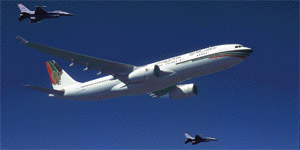STEVE NICHOLS
Potential airborne emergencies could be easier to manage thanks to a new dual-band VHF/UHF air-band radio jointly developed by Honeywell (Hall 1, A15) and Rohde and Schwarz.
Military aircraft are equipped with UHF sets, while civilian aircraft work on VHF. The two are incompatible, resulting in commercial airliners often being unable to talk to fighters, which are increasingly being scrambled to investigate possible problems.
While some military aircraft have VHF too, UHF-only tends to be the norm. The problem is not restricted to fighters. A civilian airline pilot at Farnborough comments that a US Lockheed Martin
C-130 recently entered his airspace and could neither communicate with him nor ATC as it only had UHF capability.

Security
With heightened security awareness around the world, fighters are often despatched to escort civilian aircraft that either deviate from their designated route or where the crew have reported potential problems. Last week, a Spanish fighter aircraft escorted an Avianca Boeing 767-200 to the Torrejon air base near Madrid after a male passenger threatened passengers and flight attendants with a knife.
Another market for the new radio is air-to-air refuelling tankers which may be outsourced to civilian organisations.
The new M3AR radio, which operates on both the civilian VHF and the UHF military bands, meets all European requirements for 8.33kHz channel spacing and immunity from FM broadcast transmitters.
Joe Longworth, director of government sales at Honeywell, says: "The US Air Force has asked for a radio that can communicate on both bands and the M3AR is ideal for this role."
Source: Flight Daily News




















